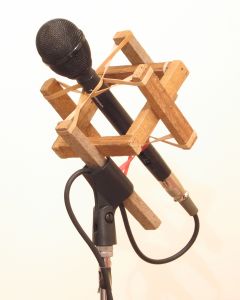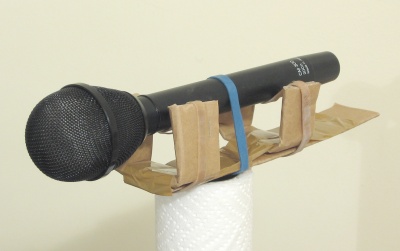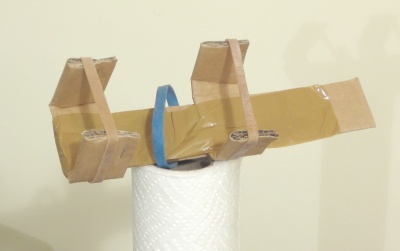This is the first microphone suspension cradle that I built, well over twenty years ago (see the adjacent picture). It was made out of a scrap length of wood I found in the shed, cut into lengths and nailed together. One spur-of-the moment job to quickly make a shockmount, and I end up with a gadget that lasted for donkey's years… And over those years, various different different things have been used for suspending the microphone in it—rubber bands, elastic cord, and bungee cord from octopus straps.
For those intending to copy this, use something other than rubber bands (they twang if you move the thing around), try some covered elastic (as used in clothing), or o-rings (they have no corners to pluck against each other). Also, if your bands aren't too long, avoid having bands cross over each other (as in the photo), that's another cause of twanging and rubbing noises. And the bottom strut could have been made from fatter wood, to better fit into ordinary mike clamps; and longer, to hold a pop-filter/spit-screen in front.
But it works well—the wood is quiet, the suspension bands isolate the microphone, the microphone sounds the same as when it's not in the shockmount—but is fairly bulky. It certainly wasn't suitable for mounting on a camera, nor was it particularly suited for using on the end of a hand-held boom pool, but was fine for removing noises transmitted through the floor and furniture when mounted on floor or desk stands. Later on, I wanted a suspension cradle that could be mounted on the camera, so I built something else.
I don't really like using microphones mounted on cameras, but sometimes you just have to make do. Camera-mounted mikes are usually too far away from your sound source, and too near to other sound sources that you don't want to record (lens and VTR motors, clicky switches, your breathing, tripod noises). And you often don't want the sound to change while panning and tilting, it's particularly noticeable how the accoustics change when you move directional microphones around.
The second time around, I opted for something very simple. I used three strips of relatively thick aluminium. One was a straight piece that would be held by the camera's mike clamp, serving as a backbone. The other two strips were bent into a “U” shape, with the bent part gaffer-taped on top of the backbone, the two of them spaced apart. Elastic bands were placed around these “U” sections, the microphone was placed on top of them. And another elastic band was then placed over the top of the mike, between the two “U” sections, holding the mike down onto the contraption. The lengths of the three aluminium sections were kept as short as possible, so it didn't act like a tuning fork and start resonating when it, the tripod, or the camera, was tapped.
Again, this was another of those spur-of-the-moment gadgets that only took a few minutes to build (two hacksaw cuts, a bit of filing, bending, and gaffer taping), and lasted several years. But since this shockmount disappeared some time ago, I can't actually show you it, so here's a cardboard mock-up of what it used to look like:
This (the original, not the cardboard mock-up) worked fairly well, was simple, small, and strong. But the elastic and gaffer tape needed replacing from time to time, and the whole thing vanished sometime during the last few years. I couldn't find anywhere local selling aluminium strips, anymore, and other plans for making shockmounts didn't look too good.
e.g. I've seen plans on the internet for using PVC plumbing pipes to make a shockmount. You get a small tubular section, and cut slots into it to fit the suspension bands in place, with the microphone being cradled inside the pipe. A problem that I'd expect from this approach would be strange accoustic effects from enclosing part of the microphone, just like cupping your hands around your ear. Though I'd expect that cutting away most of the cylinder, to leave just a skeleton ring and supporting struts, would minimise that effect.
And after finding that you could buy a RØDE SM5 shockmount for only $50, I couldn't be bothered trying to build another one. I'll save the next round of custom-building microphone gadgets for when I want a blimp mike windshield for my long shotgun mike. The cheapest one of them that I've seen was around the $500 mark, and not long enough for my microphones.


